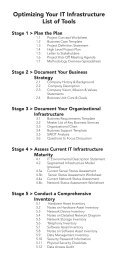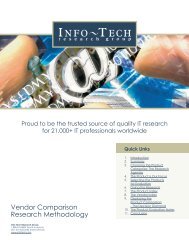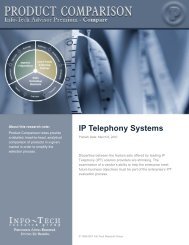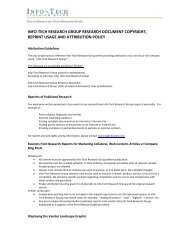Top 10 Energy-Saving Tips for a Greener Data Center - Info-Tech ...
Top 10 Energy-Saving Tips for a Greener Data Center - Info-Tech ...
Top 10 Energy-Saving Tips for a Greener Data Center - Info-Tech ...
You also want an ePaper? Increase the reach of your titles
YUMPU automatically turns print PDFs into web optimized ePapers that Google loves.
2. Foster communication between IT and facilities. For the most part, energy costs are invisibleto the IT department because the electricity bill is managed by the facilities department,independently of data center personnel. This problem is exacerbated in small IT shops becausein many cases the data center exists in a shared facility where power and cooling are metered atthe building level and accounted <strong>for</strong> as corporate “general and administrative” expenses. Thisallows IT to remove itself from the problem and not worry too much about how much energy iswasted. The majority of IT departments don’t know what the annual energy spend is <strong>for</strong> the datacenter and IT and facilities departments don’t generally coordinate ef<strong>for</strong>ts unless there’s arelocation involved.However, <strong>for</strong> energy savings to be realized, there needs to be better visibility into what the otherside is doing. IT needs to understand how purchasing decisions affect facilities and what thebaseline is in order to track improvement. Similarly, facilities must know ahead of time what’scoming down the pipeline in terms of power, space, and cooling requirements. Virtually all energyefficiency-related metric gathering initiatives should be joint IT-facilities projects.3. Track and manage the energy consumption of IT equipment. Tracking energy usage in thedata center provides a baseline <strong>for</strong> calculating the ROI of new energy saving initiatives and helpsidentify areas of opportunity. Moreover, energy management products can reduce energy useduring regular operation and can keep critical applications running during brown-outs.Best of breed products will track and manage power intake, monitor inlet/outlet air temperatures,and allow administrators to throttle server CPU per<strong>for</strong>mance to match requirements and savepower. As an example, HP recently announced Insight Power Manager (originally introduced as ablade product). The software allows administrators to track and adjust how much power serversare using. IBM’s PowerExecutive offers similar functionality.In order to monitor non-IT equipment such as air conditioning and UPS devices, involve the facilitiesdepartment. For small facilities with shared air conditioning and electricity metering, these metricsmay be difficult to obtain. In this case, consider investing in “smart metering” capabilities thatseparately measure usage in different areas and provide the desired level of granularity.4. Engage in longer-term capacity planning <strong>for</strong> power and cooling infrastructure. The growthin electrical and cooling requirements may cause a shortage of power and cooling capacity in theenterprise’s data center. A critical extension to right-sizing equipment is using energyconsumption data to develop <strong>for</strong>ecasts, assess future capacity requirements, and avoidunpleasant surprises. Since expanding or building a new data center may not be an option, takesteps now to reduce energy consumption and improve current capacity utilization.Operate & Optimize 7<strong>Top</strong> <strong>10</strong> <strong>Energy</strong>-<strong>Saving</strong> <strong>Tips</strong> <strong>for</strong> a <strong>Greener</strong> <strong>Data</strong> <strong>Center</strong>







